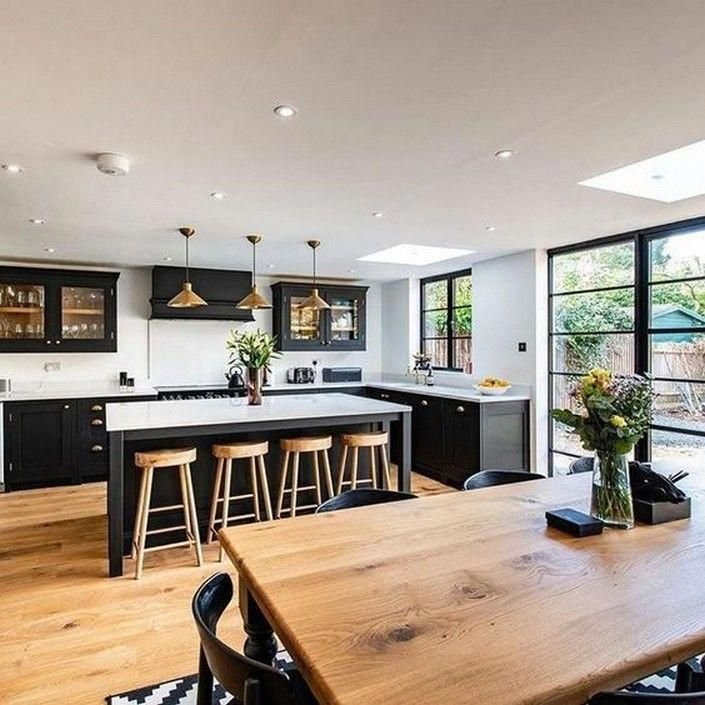The kitchen has long been considered the heart of the home, a place where families gather to cook, dine, and connect. In recent years, the popularity of open concept kitchen designs has soared, as homeowners seek to create seamless and inviting living spaces that promote interaction and flow. Open-concept kitchens offer a myriad of benefits, from maximizing natural light and space to facilitating socializing and entertaining. In this comprehensive guide, we’ll explore the principles of open-concept kitchen design, discuss its advantages and challenges, and provide practical tips for creating a spacious and functional living area with seamless integration.
Understanding Open Concept Kitchen Design
Open concept kitchen design eliminates barriers and partitions between the kitchen, dining area, and living room, creating a unified and fluid space that encourages movement and interaction. By removing walls and architectural boundaries, open-concept kitchens promote a sense of openness, connectivity, and continuity throughout the home. This design approach maximizes natural light, enhances visual flow, and allows for flexible use of space, making it ideal for modern lifestyles and entertaining.
Advantages of Open Concept Kitchen Designs
Increased Natural Light
One of the primary benefits of open-concept kitchen designs is the enhanced access to natural light throughout the living area. Without walls or partitions obstructing the flow of light, natural sunlight can penetrate deeper into the space, creating a brighter and more inviting atmosphere. This not only improves visibility and ambiance but also reduces the need for artificial lighting during the day, leading to energy savings and a more sustainable home environment.
Enhanced Connectivity and Socializing
Open-concept kitchens promote connectivity and socializing by allowing family members and guests to interact seamlessly across different areas of the home. Whether cooking, dining, or relaxing, individuals can engage in conversation and activities without feeling isolated or confined to separate rooms. This fosters a sense of togetherness and community, strengthening family bonds and facilitating meaningful interactions among household members.
Flexible Use of Space
Another advantage of open-concept kitchen designs is the flexibility they offer in terms of space utilization and furniture arrangement. Without fixed walls or partitions dictating the layout, homeowners have the freedom to configure the space according to their needs and preferences. This allows for versatile use of the kitchen area, whether for informal gatherings, formal entertaining, or everyday activities such as cooking, dining, and working.
Challenges of Open Concept Kitchen Designs
Noise and Privacy
One potential challenge of open-concept kitchen designs is the lack of acoustic separation and privacy between different living areas. With the kitchen open to the dining and living spaces, noise from cooking, appliances, and conversations can travel more easily throughout the home, potentially disrupting quiet activities or conversations in adjacent areas. To mitigate this issue, homeowners can use sound-absorbing materials, strategic layout design, or zoning techniques to create designated quiet zones within the open concept space.
Visual Clutter and Organization
Another challenge of open-concept kitchen designs is the potential for visual clutter and lack of organization, particularly in areas where different functions overlap or intersect. Without defined boundaries or partitions, it can be challenging to maintain a cohesive and clutter-free aesthetic, especially in busy or high-traffic areas such as the kitchen. To address this challenge, homeowners can utilize storage solutions, organizational systems, and strategic furniture placement to minimize visual clutter and create designated zones for specific activities.
Practical Tips for Creating an Open-Concept Kitchen
Maximize Natural Light
Optimize natural light in your open-concept kitchen by maximizing windows, doors, and skylights to allow for ample sunlight penetration throughout the space. Choose light-colored finishes, reflective surfaces, and strategically placed mirrors to enhance brightness and create a sense of openness and airiness.
Define Functional Zones
Create defined functional zones within your open-concept kitchen to delineate different areas for cooking, dining, and lounging. Use area rugs, furniture placement, or architectural elements such as half walls or columns to visually separate the kitchen from adjacent living spaces while maintaining a sense of continuity and flow.
Incorporate Multifunctional Furniture
Select multifunctional furniture pieces and accessories that serve dual purposes and optimize space utilization in your open-concept kitchen. Choose kitchen islands with integrated storage, extendable dining tables, or convertible seating options that can easily transition between different activities and accommodate varying group sizes.
Use Cohesive Design Elements
Maintain a cohesive design aesthetic throughout your open-concept kitchen by using consistent color palettes, materials, and finishes across different areas of the space. This creates visual harmony and unity, allowing for seamless integration and flow between the kitchen, dining area, and living room.
Conclusion
In conclusion, open-concept kitchen designs offer a versatile and stylish approach to modern living, creating spacious and functional living areas with seamless integration and connectivity. By removing barriers and partitions between the kitchen, dining area, and living room, homeowners can maximize natural light, enhance socializing and entertaining, and create a flexible and adaptable space that meets their lifestyle needs and preferences. While open-concept kitchens present challenges such as noise management and visual clutter, practical tips and design strategies can help mitigate these issues and optimize the functionality and aesthetics of the space.
When planning your open-concept kitchen remodel, consult with design professionals, contractors, or remodeling specialists to explore customization options and make informed decisions that align with your vision and budget. With careful consideration and strategic implementation of design principles and tips, you can create an open-concept kitchen that not only enhances the beauty and functionality of your home but also promotes connectivity, interaction, and enjoyment for years to come.


